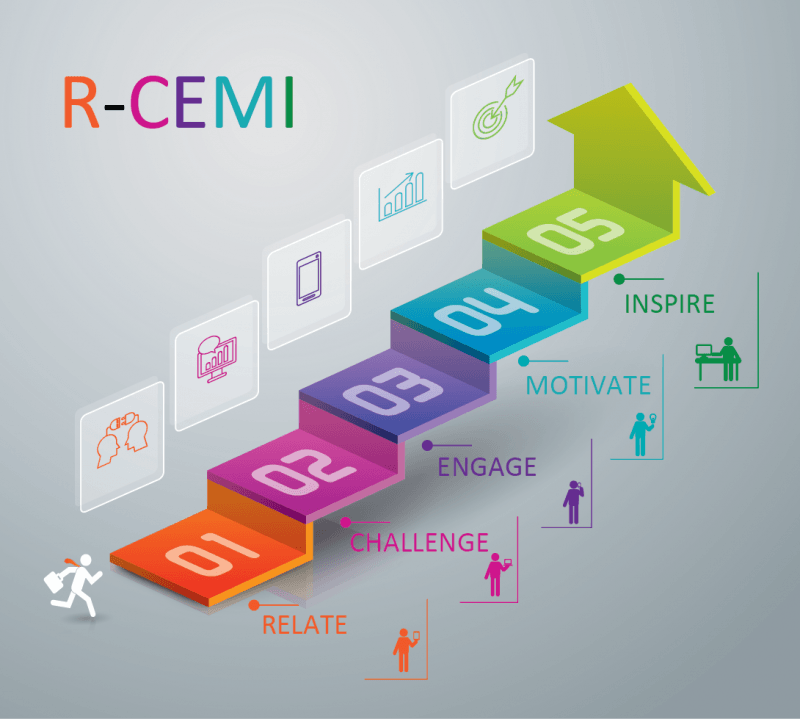Learner Engagement: Why Are Learners Not Engaged And Motivated To Learn At Work?
If you’re in charge of learner engagement and motivation, you’re probably looking at a new Learning Management System, gamification, microlearning, mobile learning, AR/VR, and other hot trends as an answer to your question:
Why are learners not engaged and motivated to learn at work?
Before you would invest time and resources in new technology, let’s take a step back and revisit engagement and motivation! (More on why motivation doesn’t work: Why Motivating People Doesn't Work . . . and What Does by Susan Fowler).
People spend significant amount of informal learning time on YouTube, social media, forums; they’re asking peers constantly for answers. They are engaged and motivated. So, the question is not why they are not engaged and motivated at work, but how you can engage and motivate them to learn.
With engaging content to develop talent, right?
“I’m a human resource, develop me!” – said no one ever with full of engagement and motivation. On the other hand, employees do want to grow and learn when challenged at work.
Let's Train And Develop Talented Humans! Josh Bersin Says: Not Really!
What if our job was to help them grow, rather than developing them? To show relevance to their goals, instead of highlighting measurable learning objectives? To facilitate connections, shared knowledge in the workplace ecosystem, rather than locking vital information in courses? Are we doing a good job retaining talent that way? Josh Bersin says not really:
“We can't 'retain' people, we can only 'attract them'. We can't 'engage them' but we can "inspire and support them." We can't only 'train them' but we can 'enable them to learn' and 'give them the opportunities to develop'. – Josh Bersin
Josh Bersin’s article is exploring the mindset shift from retaining, developing and training “human resources” to providing them engaging opportunities to grow. So, let’s keep humans in mind for the rest of the article! How do you translate all this into some practical example for humans, like designing an eLearning course? (Assuming you do need an eLearning course, based on Cathy Moore’s action mapping.)
Learner Engagement For Humans: 5 Design Steps
Step 0: Grab Attention!
If you asked people about their last eLearning experience, what words would you hear from them? That human (resource), who’s about to take a course has a workload, a demanding boss, hectic work environment, crazy deadlines, an ongoing life. Life before, during, and after your course. That human is only a learner for 10-15 minutes, while human for a life. Therefore, you must show the relevance to each phase. Focusing on only the “learning” (during) reduces your chances to get them engaged.
Tip: Attention grabbing may happen even before the learning event. How about an email with a short scenario? Learners will find the answer in the course.
Step 1: Relate.

Most of the time, however, the Grab Attention! step cannot happen before the learning event. In that case, you must integrate it with Step 1: Relate.
"Content is King!" says the old wisdom. Not anymore! Context is King and Action is Queen! Give humans clear answers to their two fundamental questions:
How does this course relate to me?
What do you want me to do differently after this course?
Remember, you must show the relevance to each phase of human life, not only the “learning” (during). Humans may pass a course with flying colors, yet, with no intention or knowledge how and when to apply it after. If you’re merely measuring completion and seat time, this is good news. You’re done. If you’re focusing on actual business goals, read on!
This is where Instructional Designers usually bring up my favorite discussion topic of the learning experience: learning objectives.
Have you ever tried a bottle of Smartwater? They’re tasty, measurable and smart. But that’s not the only way to deal with thirst.
So, let me ask you this: What’s the goal of your learning objectives?
- To prime learning, as in guide the learner’s focus? (Research shows it does help.)
- Engage learners to take the actual course, so you can count on completion data?
- Motivate learners to apply knowledge or skill to grow?
There’s no good or bad answer here, but you must be clear about your goals when designing the experience. Listing Learning objectives on the first page may not be the only way (to attempt) to grab their attention and show relevance.
Tip: For example, show them a realistic scenario, a question to ponder about, consequences of actions at the company due to lack of knowledge or skill. And this brings us to Step 2: Don’t be afraid to challenge them!
Step 2: Challenge.

Don't be afraid of challenging them, at the same time, provide a scaffolding positive feedback mechanism with time to reflect.
Humans get engaged when they’re challenged to use their brain, not when they have to move their mouse.
At this time, you probably hear your Subject Matter Experts and stakeholders voice in your head: "Challenges can be frustrating! What if they don’t know the answer? You wouldn’t want them to fail, would you?"
Tip: Here’s a suggestion to avoid frustration. Provide a basic challenge in a well-defined context. Give them the option for a hint. If they don’t use the hint but select the right answer, acknowledge their achievement, and add some complexity to the challenge. Tell humans they will find the correct answer by the end of the module. You’ve just created an open loop!
Step 3: Engage.

The human brain is wired to close open loops (like cliff hangers). Humans do want to know what answer is to the more complex scenario you presented previously, so use this to keep them engaged. Show their progress, keep them challenged, while scaffolding their experience with a positive feedback loop. Don’t throw them under the bus, rather put them in the driver’s seat with adequate support. Michael Allen has more details on how to implement CCAF (Context, Challenge, Activity, Feedback) in his book. Think of it as loops within the overall progress. I like to visualize them as a cone spiral, as every loop builds on the previous one getting more and more challenging (and wider).
Tip: Feedback (and reflection on the feedback) is where learning happens. "Incorrect" and "Great Job!" don't add value and just burn the working memory. Feedback doesn't always have to be text either. Games have mastered feedback as a primary tool of engagement. Read more on Karl Kapp's blog about feedback used as a game element.
Step 4: Motivate.

So far, we’ve addressed the before and during human stages. You probably know that a learning event and its content will be forgotten (see the Ebbinghaus forgetting curve) soon, if not reinforced after the event. But did you know that Ebbinghaus came up with his forgetting equation based on memorizing nonsense syllables? How often do you need to recall nonsense syllables at work? Benedict Carey argues in his book1 that forgetting is not simply the decay of human memory but a filter powering the mind to enable and deepen learning itself. While you have control over engagement during a learning experience, you probably have much less say about what happens to the humans after. Therefore, you need to design the learning experience to motivate humans to apply their knowledge or skill. How?
Tip: Do not design the experience for yourself! What motivates you, may not motivate everyone.
Motivation is an illogical beast! The challenge you’re facing is that humans are not motivated by the same things. Some like competing, some like social interactions, others prefer certificates to show their progress. Cognitive neuroscience has been providing some additional clues recently as to what happens in the brain when humans are engaged and motivated. Game Thinking, the practical application of engagement and motivation, also helps you become more effective in that space. Approaches such as Andrzej Marczewski’s RAMP2 (Relatedness, Autonomy, Mastery, and Purpose) or the self-determination theory’s ARC (Autonomy, Relatedness, Competence) are good places to start digging for additional gun powder to attack this beast.
Tip: Here’s some practical motivational takeaways:
- Don’t rely on extrinsic motivation only (rewards, money, prize). They may boost initial motivation but often backfire in the long run.
- If you don’t know Julie Dirksen, stop reading this! Read her book, Design For How People Learn, first! Especially, the chapter about… Surprise: Motivation!
- Per Susan Fowler, motivation is a skill. Humans can learn to choose and create optimal motivational experiences for themselves driven intrinsically by the self-determination theory (autonomy, relatedness, and competence).
- Is there a social platform available? Give them a challenge to share how they used their skills within a week.
- Have them type/write down how they’re going to apply the knowledge. Maybe think of a person they want to share this knowledge with? Any workplace anchors that will trigger motivation can help them remember.
- If you don’t have any time to read research or books, at least check out Daniel Pink’s TED talk.
The goal is to provide different avenues for humans to find their own intrinsic motivation, rather than motivating them get somewhere directly. It’s not just about where they want to be, it’s as much as about why and how they get there.
Step 5: Inspire.

In the long run, humans are measured on their performance at work. A short-term motivation may reinforce the application of learning, but it’s rare that you can “teach” everything humans need to be able to do within the learning experience. Therefore, you must design the experience to inspire them to learn more, use resources, be social, work out loud (show their work).
Tip: Use the whole workplace ecosystem (formal and informal learning tools and platforms) available for humans to grow, to inspire them to do more they thought they ever could without learning after your course.
Conclusion
Ultimately, it’s not just the points, badges, or even money that will engage and retain talents. It’s the intrinsic motivation from the combination of ARCS (Attention, Relevance, Confidence, Satisfaction) for before/during and ARC/RAMP (Relatedness, Autonomy, Mastery, and Purpose) for after life of every human at work. Remember these 5 steps next time when designing a learning experience for humans!
Tip: You don't have to do this alone! Connect with others on social media (here's how and why), work out loud! Share best practices and worst failures! At the end of the day, we are all humans.
References:
- Carey, Benedict (2014). How We Learn: The Surprising Truth About When, Where, and Why It Happens (Kindle edition).
- Marczewski, A. (2015). User Types. In Even Ninja Monkeys Like to Play: Gamification, Game Thinking, and Motivational Design (1st ed., pp. 65-80). CreateSpace Independent Publishing Platform.










